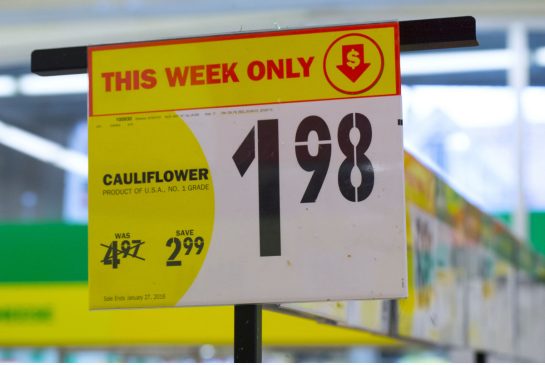|
Those who enjoy or at least tolerate cauliflower will be relieved to find it is returning to its status as blandly affordable. The low-key vegetable has become an unexpected symbol of Canada’s fallen currency and the sharp rise of food prices across the country.
Following a Toronto Star story on the cauliflower panic — when the going rate was around $7 per head — the New York Times declared cauliflower a “luxury” in this country. The Washington Post wondered about the “absurd” prices faced by American families as cauliflower rocketed in popularity. Also read, Soaring prices sour Toronto restaurateurs’ taste for cauliflower. The U.S. news website Quartz labelled cauliflower “white gold,” though a comparison to black gold was more telling. Last week, when a barrel of oil closed at $31 (U.S.) and a Canadian dollar was worth just 69 cents (U.S.), a barrel of oil cost the same as five cauliflowers. But it seems local grocers have responded to the outcry. The modest cauliflower is now selling for more reasonable prices throughout the GTA, even selling for as low as less than $2. At some Food Basics stores, it will be on sale for $1.98 until Jan. 27, a spokesman confirmed. “It was a very interesting market reaction to all the stories you heard about cauliflower,” said Sylvain Charlebois, food policy expert and professor of marketing and consumer studies at the University of Guelph. “I’ve never spoken about cauliflower in my life as much as the last week.” Charlebois believes retailers decided to put cauliflower on sale at a loss to appease customers. “Retailers are very good at knowing what the market can bear,” he said. Besides the weak loonie, wildly unpredictable weather in southern U.S. states left cauliflower in scarce supply, helping drive prices upward. “The growing cycle was all messed up,” said Mark McBride, who sells 25 crops for Coastline Produce, located in Salinas, Calif. “I’ve never seen anything like the weather we had in the latter half of 2015,” said McBride, who has been in the business for 40 years. Late last year, central California crops finished before the southern crops were large enough for market. Unusually warm temperatures early in the latter growing season were followed by a cold snap that shocked the plants and slowed their growth. Similar conditions have led to price spikes in celery, green onions, tomatoes, lettuces, berries and other imports. “There was very, very tight supply, very limited amounts of product from all growers,” he said. But recent mild weather allowed the cauliflower to boom over the past two weeks, about the time it takes to move a cauliflower on a truck from a farm in Salinas to a store in Toronto. “Supplies have mushroomed,” McBride said, “pushing prices down.” Those prices peaked at Christmas, when wholesalers were forced to sell a case of 12 cauliflowers for almost $100 — more than double the $40-price in mid-November. That fell to around $80 at the beginning of the month, then dropped between $30 and $35 this week. “It’s been free-falling as we’ve gone through January,” said Yonan Mintz, vice-president of sales and marketing for Hilite Fine Foods, a boutique wholesaler that sells produce to restaurants in the GTA. The cauliflower is in the midst of a renaissance among health-conscious foodies and restaurateurs. Past Toronto Star cauliflower headlines include “You can freeze cauliflower” (1991) and “Cheese makes cauliflower superb” (1987). More recently, however, it’s made a name for itself by finding its way onto trendy restaurant menus, served as a $17 “steak” or seared in duck fat. At Fat Pasha, a whole head of roasted cauliflower sprinkled in pomegranate seeds and stuffed with cheese became one of the Toronto restaurant’s most popular dishes. It recently vanished from the menu due to the cost — but will be back as of Friday. “The price dropped dramatically after all those articles,” said owner Anthony Rose. His wholesale supplier noticed. “They called us right away, literally within 24 hours after everything was published and said, ‘You can do cauliflower again,’ ” Rose said. But lovers of cauliflower should cash in soon — the $1.98 price is just a sale, said Mark Bernhardt, a spokesman for Metro Ontario Inc., which owns Food Basics. Bernhardt wouldn’t speculate how much it might cost when the sale is over. Cauliflower comparison Prices as of Wednesday — use a price comparing app like Flipp or compare flyers because many stores allow price matching. Food Basics: $1.98 Sobeys: $3.99 Metro: $3.99 No Frills: $2.97 Superstore: $2.50 Source Zoe, Mcknight, thestar.com
0 Comments
Leave a Reply. |
Advertisement
News & Updates
Stay informed with the latest news around foodservice, agriculture and other related food news. Advertisement Opportunities
|


 RSS Feed
RSS Feed


